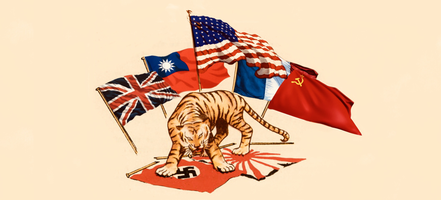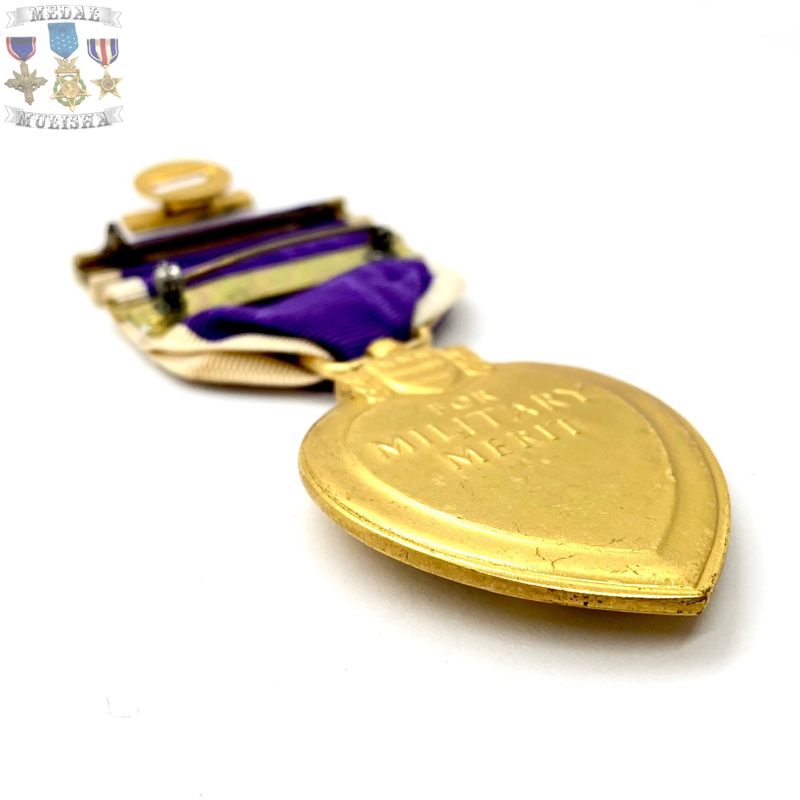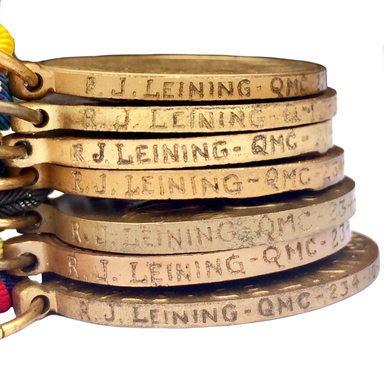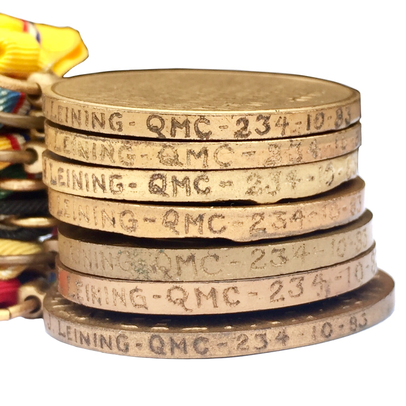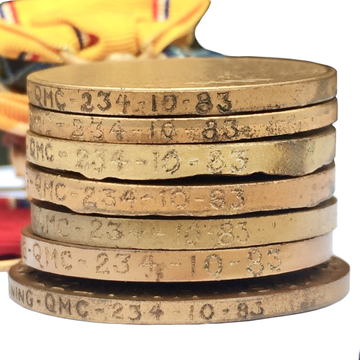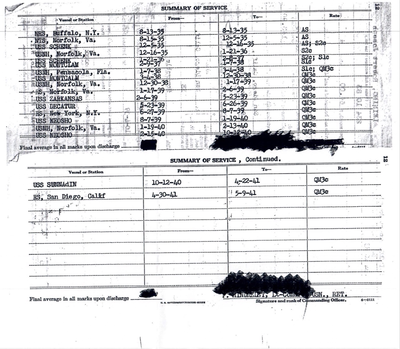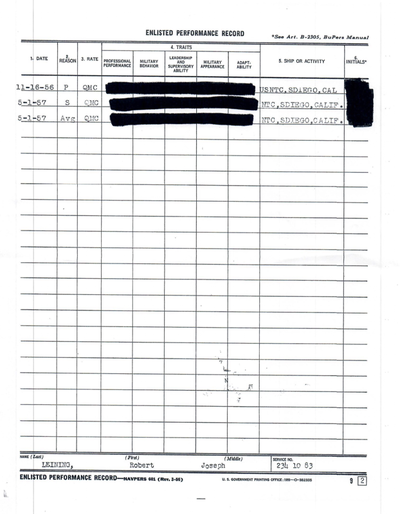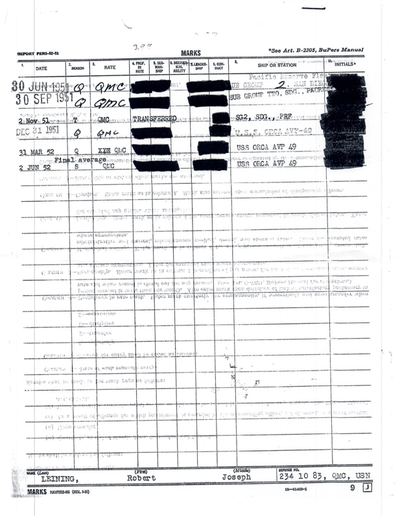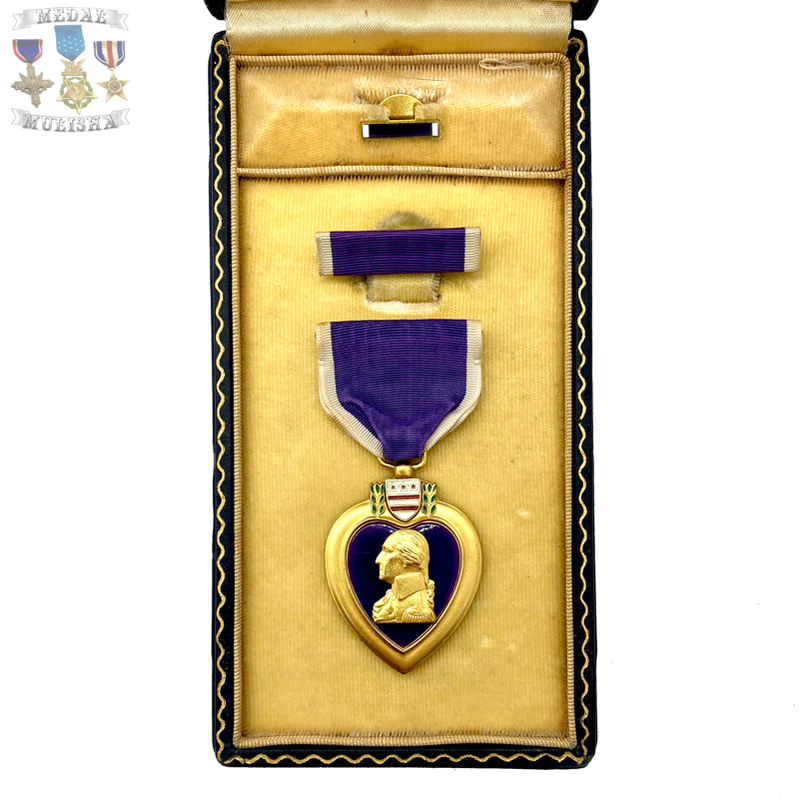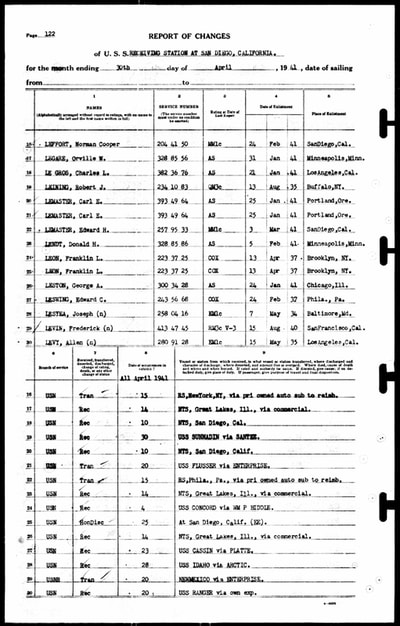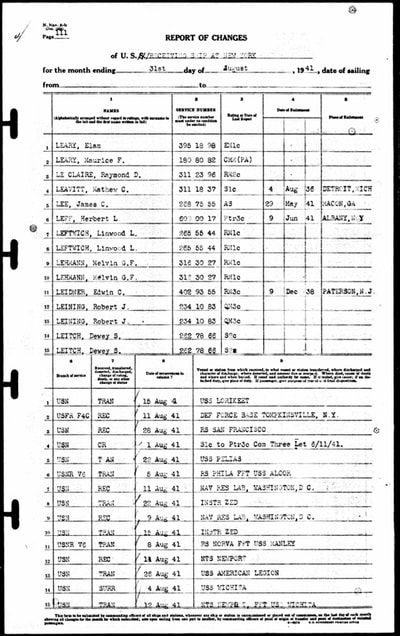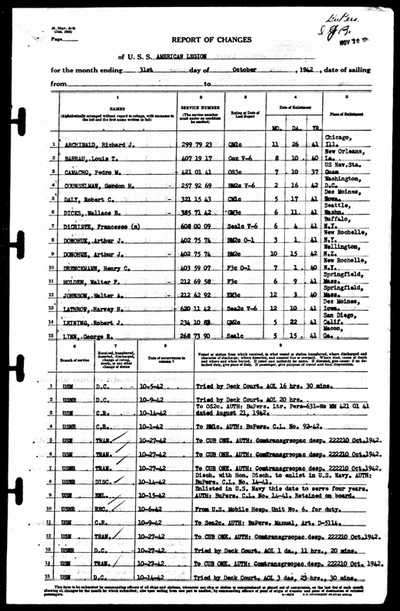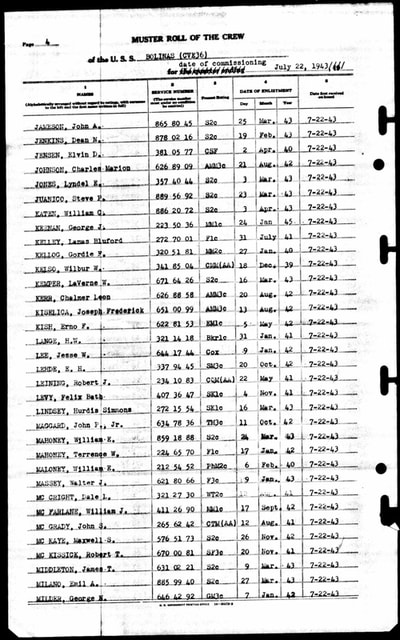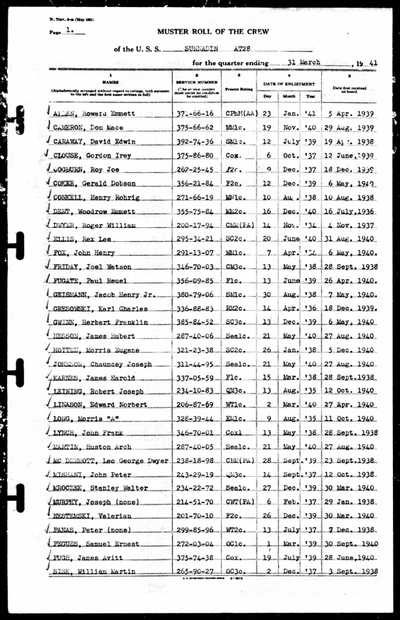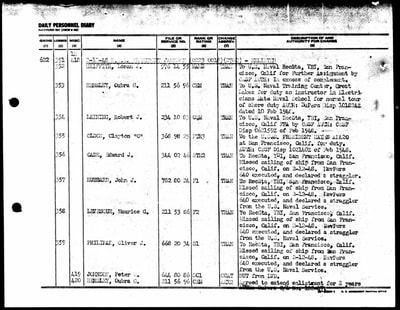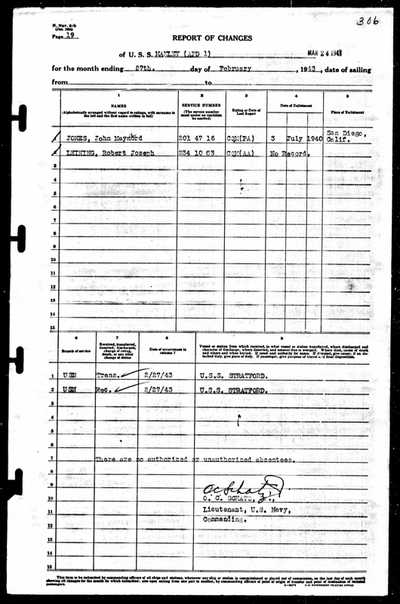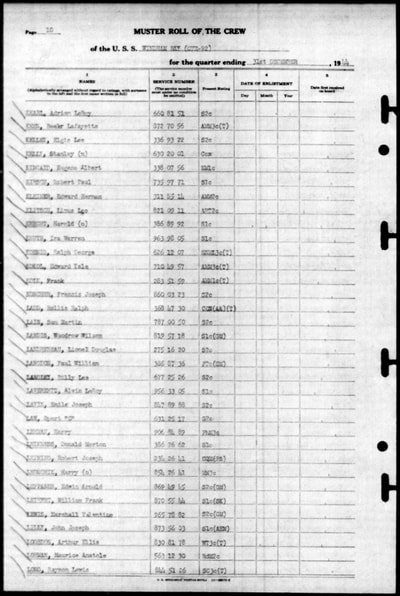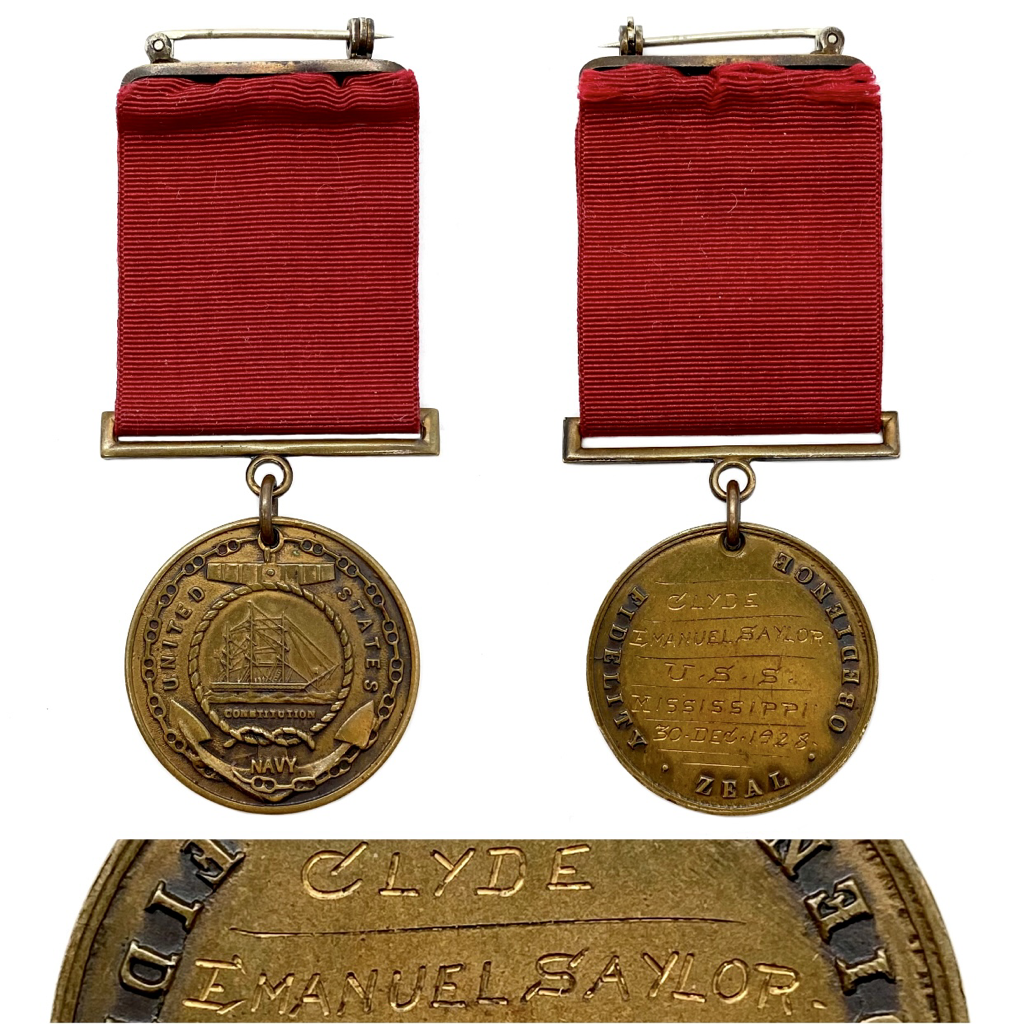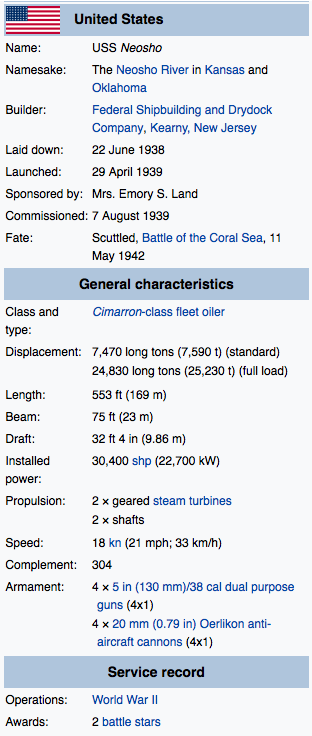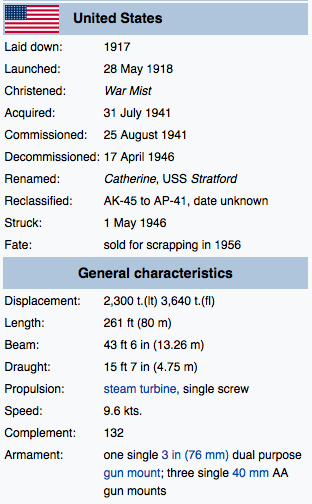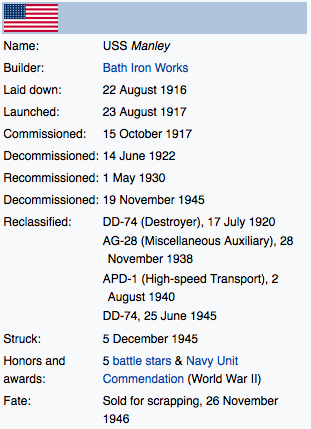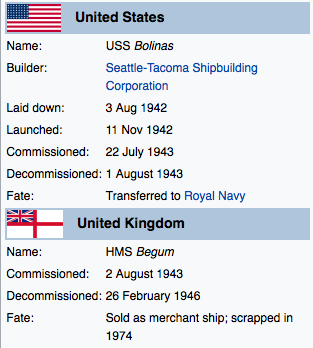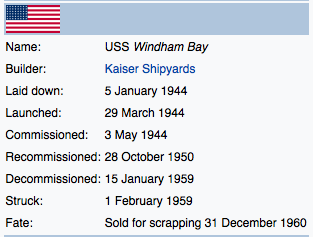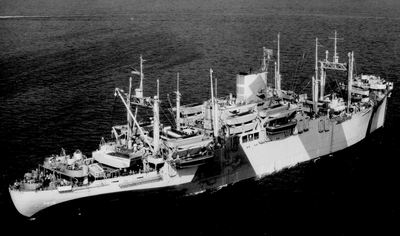ROBERT J. LEINING WORLD WAR II GROUP
QMC R. J. Leining
Quartermaster Cheif Petty Officer Robert Joseph Leining
United States Navy Quartermaster Chief Petty Officer Robert Joseph Leining (service #234-10-83) was born March 9th 1918 in Michigan.
Enlisted
Aug. 13th 1935, Buffalo, N.Y.
Norfolk, VA. Naval Receiving
Jan. 17th 1939 - Aug. 7th 1939
Fleet Oiler U.S.S. Neosho
Aug. 7th 1939 - Oct. 12 1940.
Tugboat U.S.S. Sunnadin
Oct. 12th 1940 - April 30th 1941.
San Diego, CA. Naval Receiving
April 30th 1941 - Aug. 26th 1941.
Re-enlists May 22nd 1941 San Diego, CA.
Transport U.S.S. American Legion
Aug. 26th 1941 - Oct. 27th 1942.
Transport U.S.S. Stratford
Feb. 1st 1943 - Feb 27th 1943.
Destroyer U.S.S. Manley
Feb. 27th 1943 - April 22nd 1943
Military Hospital New Caledonia
(Noumea) April 22nd 1943 - July 1943.
Escort Aircraft Carrier U.S.S. Bolinas
July 22nd 1943 - July 1943
Escort Aircraft Carrier U.S.S. Manila Bay
Oct. 5th 1943 - Aug. 17th 1944
(New Guinea Battle)
Escort Aircraft Carrier U.S.S. Windham Bay
Aug. 18th 1944. - March 7th 1945
Attack Transport U.S.S. President Jackson
June 22nd 1947 - Dec. 26th 1947
June 5th 1949 - June 5th 1950
Landing Craft Repair Ship U.S.S. Creon
March 23rd 1948 - Jan. 1st 1949
Re-enlisted
June 3rd 1952
Discharged May 1st 1957.
Passed away March 28th 1982
Enlisted
Aug. 13th 1935, Buffalo, N.Y.
Norfolk, VA. Naval Receiving
Jan. 17th 1939 - Aug. 7th 1939
Fleet Oiler U.S.S. Neosho
Aug. 7th 1939 - Oct. 12 1940.
Tugboat U.S.S. Sunnadin
Oct. 12th 1940 - April 30th 1941.
San Diego, CA. Naval Receiving
April 30th 1941 - Aug. 26th 1941.
Re-enlists May 22nd 1941 San Diego, CA.
Transport U.S.S. American Legion
Aug. 26th 1941 - Oct. 27th 1942.
Transport U.S.S. Stratford
Feb. 1st 1943 - Feb 27th 1943.
Destroyer U.S.S. Manley
Feb. 27th 1943 - April 22nd 1943
Military Hospital New Caledonia
(Noumea) April 22nd 1943 - July 1943.
Escort Aircraft Carrier U.S.S. Bolinas
July 22nd 1943 - July 1943
Escort Aircraft Carrier U.S.S. Manila Bay
Oct. 5th 1943 - Aug. 17th 1944
(New Guinea Battle)
Escort Aircraft Carrier U.S.S. Windham Bay
Aug. 18th 1944. - March 7th 1945
Attack Transport U.S.S. President Jackson
June 22nd 1947 - Dec. 26th 1947
June 5th 1949 - June 5th 1950
Landing Craft Repair Ship U.S.S. Creon
March 23rd 1948 - Jan. 1st 1949
Re-enlisted
June 3rd 1952
Discharged May 1st 1957.
Passed away March 28th 1982
U.S.S. Neosho
U.S.S. Neosho was a Cimarron-class fleet oiler serving with the United States Navy, the second ship to be named for the Neosho River in Kansas and Oklahoma.
After surviving the Attack on Pearl Harbor, Neosho operated in the South Pacific. During the Battle of the Coral Sea she was attacked and set alight, but managed to keep afloat until rendezvousing with an American destroyer on 11 May 1942, who sank her with gunfire after taking off the crew.
She was laid down under Maritime Commission contract by Federal Shipbuilding and Drydock Company, Kearny, New Jersey, 22 June 1938; launched on 29 April 1939; sponsored by Mrs. Emory S. Land, wife of Rear Admiral Emory S. Land (Ret.), Chairman of the Maritime Commission; and commissioned on 7 August 1939, with Commander AV. E. A. Mullan in command.
Conversion at Puget Sound Naval Shipyard was completed on 7 July 1941, Neosho immediately began the vital task of ferrying aviation fuel from west coast ports to Pearl Harbor. On such a mission she arrived in Pearl Harbor on 6 December, discharged a full cargo to Naval Air Station Ford Island, and prepared for the return passage.
Next morning, the surprise attack on Pearl Harbor found Neosho alert to danger; her captain—Commander John S. Phillips—got her underway and maneuvered safely through the Japanese fire, concentrated on the battleships moored at Ford Island, to a safer area of the harbor. Her guns fired throughout the attack, splashing one enemy plane and driving off others. Three of her men were wounded by a strafing attacker.
For the next five months, Neosho sailed with the aircraft carriers or independently, since escort ships—now few and far between—could not always be spared to guard even so precious a ship and cargo. Late in April, as the Japanese threatened a southward move against Australia and New Zealand by attempting to advance their bases in the Southwest Pacific, Neosho joined Task Force 17 (TF 17). At all costs, the sea lanes to the dominions had to be kept open, and they had to be protected against attack and possible invasion.
As the American and Japanese fleets sought each other out in the opening maneuvers of the climactic Battle of the Coral Sea on 6 May 1942, Neosho refueled the carrier Yorktown and the heavy cruiser Astoria, then retired from the carrier force with a lone escort, the destroyer Sims.
The next day at 1000, Japanese search planes spotted the two ships and misidentified them as a carrier and her escort. 78 aircraft from Shōkaku and Zuikaku soon arrived and began searching in vain for the "carrier" force. Eventually, they gave up and returned to sink Sims and leave Neosho—victim of seven direct hits and a suicide dive by one of the bombers—ablaze aft and in danger of breaking in two. She had shot down at least three of the attackers. One of her crewmen, Oscar V. Peterson, was posthumously awarded the Medal of Honor for his efforts to save the ship in spite of his severe injuries suffered in the attack.
CPO Oscar V. PetersonSuperb seamanship and skilled damage control work kept Neosho afloat for the next four days. The sorely stricken ship was first located by a RAAF aircraft, then an American PBY Catalina flying boat. At 13:00 on 11 May, the destroyer Henley arrived, rescued the 123 survivors and sunk by gunfire the ship they had so valiantly kept afloat against impossible odds. With Henleycame word that the American fleet had succeeded in turning the Japanese back, marking the end of their southward expansion in World War II.
After surviving the Attack on Pearl Harbor, Neosho operated in the South Pacific. During the Battle of the Coral Sea she was attacked and set alight, but managed to keep afloat until rendezvousing with an American destroyer on 11 May 1942, who sank her with gunfire after taking off the crew.
She was laid down under Maritime Commission contract by Federal Shipbuilding and Drydock Company, Kearny, New Jersey, 22 June 1938; launched on 29 April 1939; sponsored by Mrs. Emory S. Land, wife of Rear Admiral Emory S. Land (Ret.), Chairman of the Maritime Commission; and commissioned on 7 August 1939, with Commander AV. E. A. Mullan in command.
Conversion at Puget Sound Naval Shipyard was completed on 7 July 1941, Neosho immediately began the vital task of ferrying aviation fuel from west coast ports to Pearl Harbor. On such a mission she arrived in Pearl Harbor on 6 December, discharged a full cargo to Naval Air Station Ford Island, and prepared for the return passage.
Next morning, the surprise attack on Pearl Harbor found Neosho alert to danger; her captain—Commander John S. Phillips—got her underway and maneuvered safely through the Japanese fire, concentrated on the battleships moored at Ford Island, to a safer area of the harbor. Her guns fired throughout the attack, splashing one enemy plane and driving off others. Three of her men were wounded by a strafing attacker.
For the next five months, Neosho sailed with the aircraft carriers or independently, since escort ships—now few and far between—could not always be spared to guard even so precious a ship and cargo. Late in April, as the Japanese threatened a southward move against Australia and New Zealand by attempting to advance their bases in the Southwest Pacific, Neosho joined Task Force 17 (TF 17). At all costs, the sea lanes to the dominions had to be kept open, and they had to be protected against attack and possible invasion.
As the American and Japanese fleets sought each other out in the opening maneuvers of the climactic Battle of the Coral Sea on 6 May 1942, Neosho refueled the carrier Yorktown and the heavy cruiser Astoria, then retired from the carrier force with a lone escort, the destroyer Sims.
The next day at 1000, Japanese search planes spotted the two ships and misidentified them as a carrier and her escort. 78 aircraft from Shōkaku and Zuikaku soon arrived and began searching in vain for the "carrier" force. Eventually, they gave up and returned to sink Sims and leave Neosho—victim of seven direct hits and a suicide dive by one of the bombers—ablaze aft and in danger of breaking in two. She had shot down at least three of the attackers. One of her crewmen, Oscar V. Peterson, was posthumously awarded the Medal of Honor for his efforts to save the ship in spite of his severe injuries suffered in the attack.
CPO Oscar V. PetersonSuperb seamanship and skilled damage control work kept Neosho afloat for the next four days. The sorely stricken ship was first located by a RAAF aircraft, then an American PBY Catalina flying boat. At 13:00 on 11 May, the destroyer Henley arrived, rescued the 123 survivors and sunk by gunfire the ship they had so valiantly kept afloat against impossible odds. With Henleycame word that the American fleet had succeeded in turning the Japanese back, marking the end of their southward expansion in World War II.
U.S.S. SUNNADIN
The first USS Sunnadin (AT-28), a tug, was laid down on 3 December 1918 at the Puget Sound Navy Yard as Katahdin; renamed Sunnadin on 24 February 1919; launched on 28 February 1919; and commissioned on 20 October 1919. It was named for an Anglicized spelling of the Huron Indian town, Sunyendeand.
Sunnadin was assigned to the 14th Naval District and spent almost a quarter of a century in the Hawaiian Islands operating from Pearl Harbor, towing Navy ships and other sea-going craft between ports in the 14th Naval District. During that time, she changed designations twice. On 17 July 1920 when the Navy first adopted alpha-numeric hull designations, she became AT-28.
She was in Pearl Harbor during the Japanese attack there on 7 December 1941. On 15 May 1944, she was redesignated ATO-28. In the fall of 1945, Sunnadin was ordered to report to the Commandant, 12th Naval District, for decommissioning and disposal. Sunnadin was decommissioned on 4 April 1946. Her name was struck from the Navy list on 8 May 1946. On 15 January 1947, she was delivered to the Maritime Commission at Mare Island, California, for disposal.
Sunnadin was assigned to the 14th Naval District and spent almost a quarter of a century in the Hawaiian Islands operating from Pearl Harbor, towing Navy ships and other sea-going craft between ports in the 14th Naval District. During that time, she changed designations twice. On 17 July 1920 when the Navy first adopted alpha-numeric hull designations, she became AT-28.
She was in Pearl Harbor during the Japanese attack there on 7 December 1941. On 15 May 1944, she was redesignated ATO-28. In the fall of 1945, Sunnadin was ordered to report to the Commandant, 12th Naval District, for decommissioning and disposal. Sunnadin was decommissioned on 4 April 1946. Her name was struck from the Navy list on 8 May 1946. On 15 January 1947, she was delivered to the Maritime Commission at Mare Island, California, for disposal.
u.s.s. american legion
American Legion was built for the United States Shipping Board (USSB), one of the planned World War I troop transports converted before construction into passenger and cargo vessels, the Emergency Fleet Corporation Design 1029 ships. The ship was laid down as Koda and perhaps assigned the name Badger State at one point, but renamed American Legion before launch and one of only a few of the design not taking a state nickname. Originally operated by the USSB's agents and the Munson Steamship Line the ship saw commercial service until laid up 13 March 1939.
American Legion was formally transferred to the War Department for use as an United States Army transport on 19 December 1939 operating as USAT American Legion until transfer to the United States Navy 22 August 1941. The Navy commissioned the ship USS American Legion initially classifying the ship a transport with hull number AP-35. On 1 February 1943 the Navy reclassified the ship as an attack transport (Harris class) with hull number APA-17. American Legion decommissioned on 28 March 1946 and was sold for scrap 5 February 1948.
American Legion was formally transferred to the War Department for use as an United States Army transport on 19 December 1939 operating as USAT American Legion until transfer to the United States Navy 22 August 1941. The Navy commissioned the ship USS American Legion initially classifying the ship a transport with hull number AP-35. On 1 February 1943 the Navy reclassified the ship as an attack transport (Harris class) with hull number APA-17. American Legion decommissioned on 28 March 1946 and was sold for scrap 5 February 1948.
USS Stratford
USS Stratford (AK-45/AP-41) was a Stratford-class transport commissioned by the U.S. Navy for service in World War II. She was responsible for delivering military personnel and equipment to ships and stations in the war zone.
Stratford (AP-41), ex-SS Catherine, was built in 1918 by the Manitowoc Shipbuilding Company of Manitowoc, Wisconsin; acquired by the Navy on 31 July 1941; and commissioned on 25 August 1941 at Baltimore, Maryland.
After completing her shakedown in the Chesapeake Bay area, Stratford sailed from Norfolk, Virginia, on 23 October, for Iceland, via New York City and Nova Scotia. She arrived at Reykjavík on 16 November 1941 and operated there until 25 March 1942 when she returned to Boston, Massachusetts. The transport made another cruise to Iceland and returned to Boston, Massachusetts, on 27 June. She was ordered to proceed to California, via Norfolk, Key West, Florida, Guantánamo Bay, and the Panama Canal Zone.
Stratford arrived at San Pedro, California, on 28 August; loaded passengers; and sailed for Hawaii three days later. She arrived there on the 11th and sailed the following week for Samoa. The transport remained in the South Pacific until April 1945. She shuttled troops and cargo from rear areas to advance bases and; as the Americans penetrated further into the Pacific, her ports of call increased. In addition to ports in New Zealand and New Caledonia, Stratfordalso operated in the Solomon, Treasury, St. Matthias, New Hebrides, Russell, and Treasury Islands as well as ports in New Guinea.
Stratford arrived at Leyte on 2 April 1945 and operated in the Philippine Islands until 1 December when she sailed for the United States, via Eniwetok and Pearl Harbor.
Stratford (AP-41), ex-SS Catherine, was built in 1918 by the Manitowoc Shipbuilding Company of Manitowoc, Wisconsin; acquired by the Navy on 31 July 1941; and commissioned on 25 August 1941 at Baltimore, Maryland.
After completing her shakedown in the Chesapeake Bay area, Stratford sailed from Norfolk, Virginia, on 23 October, for Iceland, via New York City and Nova Scotia. She arrived at Reykjavík on 16 November 1941 and operated there until 25 March 1942 when she returned to Boston, Massachusetts. The transport made another cruise to Iceland and returned to Boston, Massachusetts, on 27 June. She was ordered to proceed to California, via Norfolk, Key West, Florida, Guantánamo Bay, and the Panama Canal Zone.
Stratford arrived at San Pedro, California, on 28 August; loaded passengers; and sailed for Hawaii three days later. She arrived there on the 11th and sailed the following week for Samoa. The transport remained in the South Pacific until April 1945. She shuttled troops and cargo from rear areas to advance bases and; as the Americans penetrated further into the Pacific, her ports of call increased. In addition to ports in New Zealand and New Caledonia, Stratfordalso operated in the Solomon, Treasury, St. Matthias, New Hebrides, Russell, and Treasury Islands as well as ports in New Guinea.
Stratford arrived at Leyte on 2 April 1945 and operated in the Philippine Islands until 1 December when she sailed for the United States, via Eniwetok and Pearl Harbor.
U.S.S. Manley
USS Manley (DD-74/AG-28/APD-1), a Caldwell-class destroyer, served in the United States Navy. She was the second Navy ship named for Captain John Manley (c.1733–1793).
Manley was laid down on 22 August 1916 by the Bath Iron Works, Bath, Maine; launched on 23 August 1917; sponsored by Miss Dorothy S. Sewall; and commissioned on 15 October 1917, Commander Robert L. Berry in command. She was redesignated DD-74 on 17 July 1920.
At dusk on 11 April 1942, she picked up 290 survivors from the torpedoed merchant passenger steamer SS Ulysses, and landed them at Charleston, South Carolina the following day. On 13 July 1942 Manley transited the Panama Canal for duty with the Pacific Fleet. Touching the Society and Fiji Islands, she reached Espiritu Santo, New Hebrides on 14 August, and loaded special cargo for Guadalcanal, invaded only one week earlier.
Carrying bombs, ammunition, and gasoline, Manley and Stringham (DD-83) got underway on 16 August. After exchanging their cargo for wounded marines, they returned to Espiritu Santo on the 19th. Manley was ordered to take torpedoed Blue (DD-387) in tow for Tulagi harbor before nightfall. Since a Japanese surface force was approaching, it was necessary to scuttle the destroyer. Manley took 99 survivors on board. Only two hours of fuel remained when the ship made it back to Espiritu Santo on the 26th.
Ordered to cut out all topside weight on the ship, her crew removed everything not essential to survival, painted the ship jungle green and covered her with camouflage nets. Thus arrayed, the high-speed transport made another trip to Guadalcanal on 3 September 1942. After Little (APD-4) and Gregory (APD-3) were sunk at night of 5 September, she rescued five survivors the next morning.
On 8 September 1942 Manley took part in a surprise landing on Taivu Point, Guadalcanal, by the 1st Marine Raider Battalion. The leathernecks were put ashore at 05:00, and were reinforced by paramarines from Manley at 11:30. During the operation she bombarded Tasimboko village. The raid was a great success, and played an important role in final victory. Stores, ammunition, and equipment were destroyed and many 75 mm guns were pulled off into deep water by Higgins boats. Larger guns were dynamited, and their ammunition sunk. Reembarkation was completed by 18:30, and Manley returned to Lunga Point to put the raiders ashore.
As she was unloading, the shore station ordered her to clear out at highest speed, since a raid by Japanese heavy units was expected momentarily. With 200 marines, including wounded and dead, on board, she hoisted all boats and headed out Lengo Channel with McKean (DD-90) at 21:10. Manley had fuel for only one day's operations and so returned to Tulagi the next day. Taking on enough fuel to reach Espiritu Santo, she was routed onward for voyage repairs at Nouméa, New Caledonia.
A company of marine raiders came on board on 31 October 1942 with orders to establish a beachhead at Aola Bay, Guadalcanal. Task Force 65 (TF 65) put the marines ashore on 4 November 1942, and troops from Manley and McKean reinforced them on the 8th.
The versatile fighting ship left Nouméa on 20 November 1942 carrying six torpedoes, towing two PT boats, and escorting SS Pomona to Espiritu Santo. Here she embarked another company of raiders and sailed for Lunga Point, Guadalcanal where the raiders debarked. The PT boats and torpedoes were then delivered to Tulagi, Solomon Islands. In the following months, the high-speed transport was constantly engaged in the risky business of running supplies into Guadalcanal and escorting other ships through the dangerous Solomons.
Manley arrived at San Francisco, California on 12 June 1943 for overhaul at Hunters Point Navy Yard. Then, on 1 August 1943, Manley set sail for Hawaii. From Pearl Harbor, the veteran four-piper escorted a convoy south to Funafuti to resume her former duties in the Solomon Islands.
Manley arrived at Pearl Harbor on 14 December 1943 and joined the V Amphibious Corps to prepare for Operation Flintlock, the invasion of the Marshall Islands. She sortied on 22 January 1944 with TF 52. On the 30th she and Overton (DD-239) were detached to make a dawn strike on Carter and Cecil Islands of Kwajalein Atoll. All boats and troops were launched shortly before sunrise on 31 January 1944, and by 09:00 reported that they had killed 13 of the enemy on the island at a cost of one American killed and one wounded.
The two high-speed transports were ordered to land 7th Cavalry Regiment reconnaissance troops on Bennett Islands before dawn on 5 February, and Manley was designated fire support ship. The area was well-covered, and the operation went off on schedule.
Three days later Manley got underway as part of a transport screen for Hawaii, arriving Pearl Harbor on the 15th to train Army troops for future landings.
On 30 May Manley joined Task Group 52.15 (TG 52.15) and departed for the invasion of Saipan. The high-speed transports arrived off Saipan on the night of 14 June and landed their marines on established beaches south of Garapan on 16 June. Thereafter, except for a trip to Eniwetok for supplies and night harassing fire on Tinian Townand airports on the nights of 9, 12, and 18 July Manley operated in the transport screen until 22 July. She returned to Eniwetok on the 22nd and, after a trip to Kwajalein, sailed to Pearl Harbor, arriving on 9 August, she began preparations for the next operation.
On 10 September Manley took on board 50 tons of explosives, slated as reserves for underwater demolition team work in the proposed invasion of Yap. She left Pearl Harbor on the 15th and proceeded via Eniwetok to Manus, Admiralty Islands. There word arrived that the operation against Yap had been canceled and that the forces assembled would strike Leyte in the Philippines. Manley was then assigned to the bombardment and fire support group which arrived in Leyte Gulf early on 18 October.
After entering Leyte Gulf, Manley was assigned screening stations off the southern transport area at Dulag. On the 19th she picked up casualties from Ross (DD-563), and transferred them to Pennsylvania (BB-38). After marking a navigational buoy during the early morning hours of the 20th, she headed toward Hollandia with TransDiv 28, on the evening of 21 October.
En route, part of the convoy, including Manley, was diverted to Seeadler Harbor, Manus, Admiralty Islands, and anchored there on the 27th. After an escort trip to New Guinea, Manley returned to Seeadler Harbor. In mid-December, she shifted to Noemfoor Island for tactical exercises and training for the liberation of Luzon.
Manley sailed on 4 January 1945 as part of a reinforcement group for the landings at Lingayen Gulf, Luzon, landing her embarked troops on the 11th. Two days later she left Lingayen, escorting an LST convoy which anchored in Leyte Gulf on 18 January.
Manley was one of four high-speed transports assigned to an assault landing at Nasugbu, Luzon, on 31 January. With elements of the 11th Airborne Division, Manleyarrived at Nasugbu Bay on 31 January and landed troops in two waves without resistance. That afternoon Manley returned to Leyte. She proceeded to Mindoro for fueling, and then escorted a convoy to Subic Bay.
To block retreat by the Japanese into Bataan, Manley with TransDiv 100 and six LCI(L)'s, put some 700 assault troops ashore at Mariveles on 15 February 1945. On the 17th, she landed troops on Corregidor. Hidden gun emplacements shelled her boats, sinking one and wounding an Army officer, but the landings succeeded. That evening the transport returned to Subic Bay.
On 2 April the transport joined the screen of escort aircraft carriers loaded with the first land-based planes to be sent to Okinawa. The first section of the task group launched planes to land on Okinawa on 7 April 1945. The following day Manley's task group closed the islands to launch the remainder of the aircraft for landing strips on that bitterly contested "last stepping stone" to Japan. Manley dropped depth charges on a submarine contact during the launch. Then she protected escort carriers White Plains (CVE-66) and Hollandia (CVE-97) to Guam.
Manley was laid down on 22 August 1916 by the Bath Iron Works, Bath, Maine; launched on 23 August 1917; sponsored by Miss Dorothy S. Sewall; and commissioned on 15 October 1917, Commander Robert L. Berry in command. She was redesignated DD-74 on 17 July 1920.
At dusk on 11 April 1942, she picked up 290 survivors from the torpedoed merchant passenger steamer SS Ulysses, and landed them at Charleston, South Carolina the following day. On 13 July 1942 Manley transited the Panama Canal for duty with the Pacific Fleet. Touching the Society and Fiji Islands, she reached Espiritu Santo, New Hebrides on 14 August, and loaded special cargo for Guadalcanal, invaded only one week earlier.
Carrying bombs, ammunition, and gasoline, Manley and Stringham (DD-83) got underway on 16 August. After exchanging their cargo for wounded marines, they returned to Espiritu Santo on the 19th. Manley was ordered to take torpedoed Blue (DD-387) in tow for Tulagi harbor before nightfall. Since a Japanese surface force was approaching, it was necessary to scuttle the destroyer. Manley took 99 survivors on board. Only two hours of fuel remained when the ship made it back to Espiritu Santo on the 26th.
Ordered to cut out all topside weight on the ship, her crew removed everything not essential to survival, painted the ship jungle green and covered her with camouflage nets. Thus arrayed, the high-speed transport made another trip to Guadalcanal on 3 September 1942. After Little (APD-4) and Gregory (APD-3) were sunk at night of 5 September, she rescued five survivors the next morning.
On 8 September 1942 Manley took part in a surprise landing on Taivu Point, Guadalcanal, by the 1st Marine Raider Battalion. The leathernecks were put ashore at 05:00, and were reinforced by paramarines from Manley at 11:30. During the operation she bombarded Tasimboko village. The raid was a great success, and played an important role in final victory. Stores, ammunition, and equipment were destroyed and many 75 mm guns were pulled off into deep water by Higgins boats. Larger guns were dynamited, and their ammunition sunk. Reembarkation was completed by 18:30, and Manley returned to Lunga Point to put the raiders ashore.
As she was unloading, the shore station ordered her to clear out at highest speed, since a raid by Japanese heavy units was expected momentarily. With 200 marines, including wounded and dead, on board, she hoisted all boats and headed out Lengo Channel with McKean (DD-90) at 21:10. Manley had fuel for only one day's operations and so returned to Tulagi the next day. Taking on enough fuel to reach Espiritu Santo, she was routed onward for voyage repairs at Nouméa, New Caledonia.
A company of marine raiders came on board on 31 October 1942 with orders to establish a beachhead at Aola Bay, Guadalcanal. Task Force 65 (TF 65) put the marines ashore on 4 November 1942, and troops from Manley and McKean reinforced them on the 8th.
The versatile fighting ship left Nouméa on 20 November 1942 carrying six torpedoes, towing two PT boats, and escorting SS Pomona to Espiritu Santo. Here she embarked another company of raiders and sailed for Lunga Point, Guadalcanal where the raiders debarked. The PT boats and torpedoes were then delivered to Tulagi, Solomon Islands. In the following months, the high-speed transport was constantly engaged in the risky business of running supplies into Guadalcanal and escorting other ships through the dangerous Solomons.
Manley arrived at San Francisco, California on 12 June 1943 for overhaul at Hunters Point Navy Yard. Then, on 1 August 1943, Manley set sail for Hawaii. From Pearl Harbor, the veteran four-piper escorted a convoy south to Funafuti to resume her former duties in the Solomon Islands.
Manley arrived at Pearl Harbor on 14 December 1943 and joined the V Amphibious Corps to prepare for Operation Flintlock, the invasion of the Marshall Islands. She sortied on 22 January 1944 with TF 52. On the 30th she and Overton (DD-239) were detached to make a dawn strike on Carter and Cecil Islands of Kwajalein Atoll. All boats and troops were launched shortly before sunrise on 31 January 1944, and by 09:00 reported that they had killed 13 of the enemy on the island at a cost of one American killed and one wounded.
The two high-speed transports were ordered to land 7th Cavalry Regiment reconnaissance troops on Bennett Islands before dawn on 5 February, and Manley was designated fire support ship. The area was well-covered, and the operation went off on schedule.
Three days later Manley got underway as part of a transport screen for Hawaii, arriving Pearl Harbor on the 15th to train Army troops for future landings.
On 30 May Manley joined Task Group 52.15 (TG 52.15) and departed for the invasion of Saipan. The high-speed transports arrived off Saipan on the night of 14 June and landed their marines on established beaches south of Garapan on 16 June. Thereafter, except for a trip to Eniwetok for supplies and night harassing fire on Tinian Townand airports on the nights of 9, 12, and 18 July Manley operated in the transport screen until 22 July. She returned to Eniwetok on the 22nd and, after a trip to Kwajalein, sailed to Pearl Harbor, arriving on 9 August, she began preparations for the next operation.
On 10 September Manley took on board 50 tons of explosives, slated as reserves for underwater demolition team work in the proposed invasion of Yap. She left Pearl Harbor on the 15th and proceeded via Eniwetok to Manus, Admiralty Islands. There word arrived that the operation against Yap had been canceled and that the forces assembled would strike Leyte in the Philippines. Manley was then assigned to the bombardment and fire support group which arrived in Leyte Gulf early on 18 October.
After entering Leyte Gulf, Manley was assigned screening stations off the southern transport area at Dulag. On the 19th she picked up casualties from Ross (DD-563), and transferred them to Pennsylvania (BB-38). After marking a navigational buoy during the early morning hours of the 20th, she headed toward Hollandia with TransDiv 28, on the evening of 21 October.
En route, part of the convoy, including Manley, was diverted to Seeadler Harbor, Manus, Admiralty Islands, and anchored there on the 27th. After an escort trip to New Guinea, Manley returned to Seeadler Harbor. In mid-December, she shifted to Noemfoor Island for tactical exercises and training for the liberation of Luzon.
Manley sailed on 4 January 1945 as part of a reinforcement group for the landings at Lingayen Gulf, Luzon, landing her embarked troops on the 11th. Two days later she left Lingayen, escorting an LST convoy which anchored in Leyte Gulf on 18 January.
Manley was one of four high-speed transports assigned to an assault landing at Nasugbu, Luzon, on 31 January. With elements of the 11th Airborne Division, Manleyarrived at Nasugbu Bay on 31 January and landed troops in two waves without resistance. That afternoon Manley returned to Leyte. She proceeded to Mindoro for fueling, and then escorted a convoy to Subic Bay.
To block retreat by the Japanese into Bataan, Manley with TransDiv 100 and six LCI(L)'s, put some 700 assault troops ashore at Mariveles on 15 February 1945. On the 17th, she landed troops on Corregidor. Hidden gun emplacements shelled her boats, sinking one and wounding an Army officer, but the landings succeeded. That evening the transport returned to Subic Bay.
On 2 April the transport joined the screen of escort aircraft carriers loaded with the first land-based planes to be sent to Okinawa. The first section of the task group launched planes to land on Okinawa on 7 April 1945. The following day Manley's task group closed the islands to launch the remainder of the aircraft for landing strips on that bitterly contested "last stepping stone" to Japan. Manley dropped depth charges on a submarine contact during the launch. Then she protected escort carriers White Plains (CVE-66) and Hollandia (CVE-97) to Guam.
U.S.S. Bolinas
The USS Bolinas (CVE-36) (originally AVG-36, then later ACV-36) was an escort aircraft carrier launched 11 November 1942 by Seattle-Tacoma Shipbuilding, Tacoma, Washington; sponsored by Mrs. G. B. Sherwood, wife of Commander Sherwood; and commissioned 22 July 1943, Captain H. L. Meadow in command.
On 2 August 1943 after being decommissioned Bolinas was transferred to the United Kingdom under Lend-Leaseand renamed HMS Begum (D38). Begum served with the Royal Navy during World War II, doing anti-submarine sweeps in the Indian Ocean with 832 Squadron as her complement, participating in the sinking of U-198.
After her return she was declared surplus by the U. S. Navy. She was stricken for disposal 19 June 1946 and sold by the Navy into merchant service 16 April 1947 as Raki and later I Yung. She was scrapped in Taiwan in March 1974.
On 2 August 1943 after being decommissioned Bolinas was transferred to the United Kingdom under Lend-Leaseand renamed HMS Begum (D38). Begum served with the Royal Navy during World War II, doing anti-submarine sweeps in the Indian Ocean with 832 Squadron as her complement, participating in the sinking of U-198.
After her return she was declared surplus by the U. S. Navy. She was stricken for disposal 19 June 1946 and sold by the Navy into merchant service 16 April 1947 as Raki and later I Yung. She was scrapped in Taiwan in March 1974.
U.S.S. Manilla Bay
USS Manila Bay (CVE-61) was a Casablanca-class escort carrier of the United States Navy.
She was laid down as Bucareli Bay (ACV-61) under Maritime Commission contract by Kaiser Company, Inc., Vancouver, Washington on 15 January 1943; renamed Manila Bay on 3 April 1943; launched on 10 July 1943; sponsored by Mrs. Robert W. Bockius; reclassified CVE-61 on 15 July 1943; acquired by the Navy on 5 October 1943; and commissioned the same day at Astoria, Oregon, Captain Boynton L. Braun in command.
World War II
After a shakedown cruise along the west coast, Manila Bay sailed for Pearl Harbor on 20 November and returned a load of damaged planes to San Diego on 4 December. After training exercises, with Composite Squadron 7 (VC-7) embarked, she departed Hawaii on 3 January 1944. A week later she embarked Rear Admiral Ralph Davidson and became flagship for Carrier Division 24. Joining Task Force 52 (TF 52), she sortied 22 January for the invasion of the Marshall Islands. Between 31 January-6 February, she launched air and antisubmarine patrols as well as dozens of combat missions. Her planes bombed and strafed enemy positions from Kwajalein Island north to Bigej Island and destroyed ammunition dumps and ground installations. She remained in the Marshalls during the next month and extended her operations late in February first to Eniwetok and then to Majuro.Departing Majuro on 7 March, Manila Bay reached Espiritu Santo on the 12th. Three days later she joined TF 37 for airstrikes and surface bombardments against Kavieng, New Ireland on 19–20 March. During the next month she cruised between the Solomons and the Bismarck Archipelago supporting the protracted offensive to neutralize the Archipelago and the Japanese fortress at Rabaul. Thence, on 19 April she steamed so that her planes could attack enemy positions on New Guinea.
She was laid down as Bucareli Bay (ACV-61) under Maritime Commission contract by Kaiser Company, Inc., Vancouver, Washington on 15 January 1943; renamed Manila Bay on 3 April 1943; launched on 10 July 1943; sponsored by Mrs. Robert W. Bockius; reclassified CVE-61 on 15 July 1943; acquired by the Navy on 5 October 1943; and commissioned the same day at Astoria, Oregon, Captain Boynton L. Braun in command.
World War II
After a shakedown cruise along the west coast, Manila Bay sailed for Pearl Harbor on 20 November and returned a load of damaged planes to San Diego on 4 December. After training exercises, with Composite Squadron 7 (VC-7) embarked, she departed Hawaii on 3 January 1944. A week later she embarked Rear Admiral Ralph Davidson and became flagship for Carrier Division 24. Joining Task Force 52 (TF 52), she sortied 22 January for the invasion of the Marshall Islands. Between 31 January-6 February, she launched air and antisubmarine patrols as well as dozens of combat missions. Her planes bombed and strafed enemy positions from Kwajalein Island north to Bigej Island and destroyed ammunition dumps and ground installations. She remained in the Marshalls during the next month and extended her operations late in February first to Eniwetok and then to Majuro.Departing Majuro on 7 March, Manila Bay reached Espiritu Santo on the 12th. Three days later she joined TF 37 for airstrikes and surface bombardments against Kavieng, New Ireland on 19–20 March. During the next month she cruised between the Solomons and the Bismarck Archipelago supporting the protracted offensive to neutralize the Archipelago and the Japanese fortress at Rabaul. Thence, on 19 April she steamed so that her planes could attack enemy positions on New Guinea.
U.S.S. Windham Bay
USS Windham Bay (CVE-92) was an Casablanca class escort carrier of the United States Navy. She was laid down under a Maritime Commission contract (MC hull 1129) on 5 January 1944 at Vancouver, Washington, by the Kaiser Shipbuilding Co.; launched on 29 March 1944; sponsored by Mrs. Henry M. Cooper; and commissioned on 3 May 1944, Captain Charles W. Oexle in command.
World War II[edit]Following commissioning, Windham Bay conducted shakedown training in Puget Sound and then headed for San Diego on 6 June. There, she conducted air qualifications and catapult trials before taking on a load of Hawaii-bound aircraft and passengers. She departed San Diego on 12 June and arrived in Pearl Harbor on the 19th. Trading her cargo of aircraft and passengers for a similar one bound for the Marshall Islands, Windham Bay stood out of the harbor on 25 June and arrived at Majuro on 2 July. After unloading her aircraft, she moved on to Kwajalein where she loaded planes and men of Marine Night Fighter Squadron 532 (VMF(N)-532) and headed for the Marianas. The Marines flew off near Saipan, and Windham Bay put into Garapan anchorage to unload the squadron's gear.
Afterward, the escort carrier took on a load of captured Japanese aircraft and other material for transportation back to Hawaii. She arrived in Pearl Harbor on 10 July and remained there for 15 days, getting underway for the west coast on 25 July. The warship arrived in San Diego on 31 July and soon began overhaul at San Pedro.
Repairs took the entire month of August, but she was back at sea on 1 September with a load of aircraft bound for Emirau and Manus. She arrived at Emirau at mid-month and at Manus on the 18th. From there, she voyaged to Espiritu Santo on a passenger run, returning to Manus on 5 October with a load of planes. After a brief visit to Guadalcanal during the second week in October, she got underway for the United States. Windham Bay steamed via Espiritu Santo and arrived in San Diego on 20 October. In November, she made another voyage from the west coast to the South Pacific, carrying aircraft to Manus and picking up about 350 casualties from the Palau campaign at Guadalcanal on 24 November for the return voyage to San Diego.
The escort carrier remained at San Diego from 10 December until the 27th when she resumed aircraft ferrying operations. She arrived in Pearl Harbor on 2 January 1945, unloaded one cargo of aircraft there and took on another made up of F4U Corsairs. She departed Pearl Harbor on 5 January and arrived at Midway Island on the 9th to unload the Corsairs. Departing Midway the next day, Windham Bay returned to Oahu on the 13th. On 1 February, the ship stood out of Pearl Harbor on her way to the Central Pacific. Carrying replacement aircraft for the fleet carriers of Task Force 58, she made a stop at Eniwetok on her way to the staging base at Ulithi Atoll in the Western Carolines.
From there, she operated with the 5th Fleet Logistics Group, Task Group 50.8, in support of the fast carrier strikes conducted during the Iwo Jima and Okinawa operations. During the next four months, she visited Guam and the Ryukyu Islands. On 4 June to 5 June, while steaming with the logistics group in support of TF 58 and the strikes on Okinawa, the carrier steamed right through the famous typhoon of 1945, suffering lost and damaged planes as well as damage to her flight and hangar decks. On 16 June, she cleared the Marianas en route to Oahu. The warship arrived in Pearl Harbor on the 25th but departed again two days later. She entered port at San Diego on 11 July, and immediately began repairs to correct the typhoon damage she had suffered earlier in the month. Those repairs lasted through late August, so that she missed the final weeks of the war.
On 26 August, she departed San Diego on her way back to the Central Pacific carrying Marine Fighter Squadron 312 (VMF-312) to Guam. She stopped briefly at Pearl Harbor and arrived in Apra Harbor on 15 September. After unloading passengers and cargo at Guam, Windham Bay headed for Samar in the Philippines where she arrived on 19 September. There, she loaded passengers, planes, and equipment for transportation back to Hawaii. She got underway from Leyte on 24 September, made a stop at Guam on the 27th, and arrived back at Oahu on 7 October. On the 8th, she continued eastward toward the west coast and arrived at San Diego on the 14th.
Five days later, the ship headed back to Pearl Harbor on her way to participate in Operation "Magic Carpet", the return of American servicemen to the United States. After a round-trip voyage to San Pedro, California, and back to Pearl Harbor, she set out for the western Pacific once more on 13 November. Arriving at Samar in the Philippines on the 26th, she loaded passengers and then headed east again on the 28th. She stopped at Oahu along the way and arrived in Port Hueneme, California, on 17 December. She moved to San Pedro on the 18th and remained there through the New Year.
On 8 January 1946, Windham Bay departed San Pedro, headed for Hawaii, and arrived in Pearl Harbor on 14 January. She departed Oahu again on the 15th and arrived in San Pedro on the 21st. Within days, however, she moved north to Tacoma, Washington, where she reported for duty with the Pacific Reserve Fleet on 25 January 1946. She remained there—in commission, in reserve—until 23 August 1946 when she was placed out of commission.
World War II[edit]Following commissioning, Windham Bay conducted shakedown training in Puget Sound and then headed for San Diego on 6 June. There, she conducted air qualifications and catapult trials before taking on a load of Hawaii-bound aircraft and passengers. She departed San Diego on 12 June and arrived in Pearl Harbor on the 19th. Trading her cargo of aircraft and passengers for a similar one bound for the Marshall Islands, Windham Bay stood out of the harbor on 25 June and arrived at Majuro on 2 July. After unloading her aircraft, she moved on to Kwajalein where she loaded planes and men of Marine Night Fighter Squadron 532 (VMF(N)-532) and headed for the Marianas. The Marines flew off near Saipan, and Windham Bay put into Garapan anchorage to unload the squadron's gear.
Afterward, the escort carrier took on a load of captured Japanese aircraft and other material for transportation back to Hawaii. She arrived in Pearl Harbor on 10 July and remained there for 15 days, getting underway for the west coast on 25 July. The warship arrived in San Diego on 31 July and soon began overhaul at San Pedro.
Repairs took the entire month of August, but she was back at sea on 1 September with a load of aircraft bound for Emirau and Manus. She arrived at Emirau at mid-month and at Manus on the 18th. From there, she voyaged to Espiritu Santo on a passenger run, returning to Manus on 5 October with a load of planes. After a brief visit to Guadalcanal during the second week in October, she got underway for the United States. Windham Bay steamed via Espiritu Santo and arrived in San Diego on 20 October. In November, she made another voyage from the west coast to the South Pacific, carrying aircraft to Manus and picking up about 350 casualties from the Palau campaign at Guadalcanal on 24 November for the return voyage to San Diego.
The escort carrier remained at San Diego from 10 December until the 27th when she resumed aircraft ferrying operations. She arrived in Pearl Harbor on 2 January 1945, unloaded one cargo of aircraft there and took on another made up of F4U Corsairs. She departed Pearl Harbor on 5 January and arrived at Midway Island on the 9th to unload the Corsairs. Departing Midway the next day, Windham Bay returned to Oahu on the 13th. On 1 February, the ship stood out of Pearl Harbor on her way to the Central Pacific. Carrying replacement aircraft for the fleet carriers of Task Force 58, she made a stop at Eniwetok on her way to the staging base at Ulithi Atoll in the Western Carolines.
From there, she operated with the 5th Fleet Logistics Group, Task Group 50.8, in support of the fast carrier strikes conducted during the Iwo Jima and Okinawa operations. During the next four months, she visited Guam and the Ryukyu Islands. On 4 June to 5 June, while steaming with the logistics group in support of TF 58 and the strikes on Okinawa, the carrier steamed right through the famous typhoon of 1945, suffering lost and damaged planes as well as damage to her flight and hangar decks. On 16 June, she cleared the Marianas en route to Oahu. The warship arrived in Pearl Harbor on the 25th but departed again two days later. She entered port at San Diego on 11 July, and immediately began repairs to correct the typhoon damage she had suffered earlier in the month. Those repairs lasted through late August, so that she missed the final weeks of the war.
On 26 August, she departed San Diego on her way back to the Central Pacific carrying Marine Fighter Squadron 312 (VMF-312) to Guam. She stopped briefly at Pearl Harbor and arrived in Apra Harbor on 15 September. After unloading passengers and cargo at Guam, Windham Bay headed for Samar in the Philippines where she arrived on 19 September. There, she loaded passengers, planes, and equipment for transportation back to Hawaii. She got underway from Leyte on 24 September, made a stop at Guam on the 27th, and arrived back at Oahu on 7 October. On the 8th, she continued eastward toward the west coast and arrived at San Diego on the 14th.
Five days later, the ship headed back to Pearl Harbor on her way to participate in Operation "Magic Carpet", the return of American servicemen to the United States. After a round-trip voyage to San Pedro, California, and back to Pearl Harbor, she set out for the western Pacific once more on 13 November. Arriving at Samar in the Philippines on the 26th, she loaded passengers and then headed east again on the 28th. She stopped at Oahu along the way and arrived in Port Hueneme, California, on 17 December. She moved to San Pedro on the 18th and remained there through the New Year.
On 8 January 1946, Windham Bay departed San Pedro, headed for Hawaii, and arrived in Pearl Harbor on 14 January. She departed Oahu again on the 15th and arrived in San Pedro on the 21st. Within days, however, she moved north to Tacoma, Washington, where she reported for duty with the Pacific Reserve Fleet on 25 January 1946. She remained there—in commission, in reserve—until 23 August 1946 when she was placed out of commission.
U.S.S. President Jackson
President Jackson was laid down as MC hull 53 by the Newport News Shipbuilding and Dry Dock Co., Newport News, Virginia. 2 October 1939; launched 7 June 1940; sponsored by Mrs. William G. McAdoo; and delivered to the American President Lines 25 October 1940.
After two round-the-world trips from New York City, President Jackson was acquired by the navy 30 June 1941, and commissioned 16 January 1942, Commander. C. W. Weitzel in command.
World War II Pacific Theater operations
Following shakedown and practice amphibious assault training on the U.S. West Coast, President Jackson sailed for the South Pacific 1 July 1942, as a unit of Transport Division 2. She landed the 1st Battalion, 2nd Marines, on Florida Island, Solomon Islands, 7 August 1942. At mid-month she evacuated 500 survivors of the "First Battle of Savo Island" to Noumea, then began bringing in reinforcements and evacuating casualties of land and sea actions.
Redesignated APA–18 on 1 February 1943, President Jackson continued to transport reinforcement troops and cargo in support of the consolidation of the southern Solomons. On 30 June, she landed the 172nd U.S. Army Combat Team and two construction battalion companies on Rendova, then transported survivors of USS McCawley (AP-10), torpedoed by a submarine, to Noumea.
Operating with other vessels of task force TF 31, President Jackson landed elements of the 3rd Marine Division at Empress Augusta Bay, Bougainville Island, 1 November. Seven days later, while en route back to that island with reinforcements, she was hit by a 550-pound (250 kg) bomb, which fortunately did not explode.
On 25 March 1944 President Jackson landed army, navy, and units on Emirau Island and in April, with Transport Division Two, she carried the 40th Division, to New Britain, and returned the 1st Marine Division to Russell Islands in the Solomons. With task force TF 53, in July, she landed elements of the 3rd Marine Division on Guam, 21 July, then evacuated casualties to Pearl Harbor and the United States. On 23 October the ship returned to duty with Transport Division 32 in the south and southwest Pacific areas.
While operating with TF 77, President Jackson landed elements of the 25th Infantry Division, U.S. Army, in the reinforcement landing at Lingayen Gulf 11 January 1945. On 21 February, while operating with TF 51, she landed elements of the 3rd Marine Division on Iwo Jima. Exposed to enemy counter-battery fire, she was hit once in a barrage of 37mm fire with minor damage and casualties. On 6 March she departed Iwo Jima with 515 casualties for Saipan and Noumea.
With army and navy casualties and miscellaneous passengers aboard, the transport sailed for the United States 7 May 1945. She got underway from San Francisco, 14 June and completed two round-trips to Manila before the cessation of hostilities which found her in drydock at Seattle, Washington. She then entered upon "Operation Magic Carpet" duty.
After two round-the-world trips from New York City, President Jackson was acquired by the navy 30 June 1941, and commissioned 16 January 1942, Commander. C. W. Weitzel in command.
World War II Pacific Theater operations
Following shakedown and practice amphibious assault training on the U.S. West Coast, President Jackson sailed for the South Pacific 1 July 1942, as a unit of Transport Division 2. She landed the 1st Battalion, 2nd Marines, on Florida Island, Solomon Islands, 7 August 1942. At mid-month she evacuated 500 survivors of the "First Battle of Savo Island" to Noumea, then began bringing in reinforcements and evacuating casualties of land and sea actions.
Redesignated APA–18 on 1 February 1943, President Jackson continued to transport reinforcement troops and cargo in support of the consolidation of the southern Solomons. On 30 June, she landed the 172nd U.S. Army Combat Team and two construction battalion companies on Rendova, then transported survivors of USS McCawley (AP-10), torpedoed by a submarine, to Noumea.
Operating with other vessels of task force TF 31, President Jackson landed elements of the 3rd Marine Division at Empress Augusta Bay, Bougainville Island, 1 November. Seven days later, while en route back to that island with reinforcements, she was hit by a 550-pound (250 kg) bomb, which fortunately did not explode.
On 25 March 1944 President Jackson landed army, navy, and units on Emirau Island and in April, with Transport Division Two, she carried the 40th Division, to New Britain, and returned the 1st Marine Division to Russell Islands in the Solomons. With task force TF 53, in July, she landed elements of the 3rd Marine Division on Guam, 21 July, then evacuated casualties to Pearl Harbor and the United States. On 23 October the ship returned to duty with Transport Division 32 in the south and southwest Pacific areas.
While operating with TF 77, President Jackson landed elements of the 25th Infantry Division, U.S. Army, in the reinforcement landing at Lingayen Gulf 11 January 1945. On 21 February, while operating with TF 51, she landed elements of the 3rd Marine Division on Iwo Jima. Exposed to enemy counter-battery fire, she was hit once in a barrage of 37mm fire with minor damage and casualties. On 6 March she departed Iwo Jima with 515 casualties for Saipan and Noumea.
With army and navy casualties and miscellaneous passengers aboard, the transport sailed for the United States 7 May 1945. She got underway from San Francisco, 14 June and completed two round-trips to Manila before the cessation of hostilities which found her in drydock at Seattle, Washington. She then entered upon "Operation Magic Carpet" duty.
U.S.S. Creon
USS Creon (ARL-11) was one of 39 Achelous-class landing craft repair ships built for the United States Navy during World War II. Named for Creon (the name of two mythological Greek kings, a mythological son of Heracles, and a historical Archon of Athens), she was the only U.S. Naval vessel to bear the name.
Originally laid down as LST-1036; launched 24 August 1944 by the Boston Navy Yard; sponsored by Mrs. M. A. Pratt; placed in partial commission 16 September 1944 with Lieutenant M. G. Pooley, USNR, in command; sailed to Baltimore, Maryland; decommissioned 26 September 1944 for conversion; and commissioned in full as USS Creon(ARL-11) 27 January 1945 with Lieutenant Pooley once again in command.
Service history
Clearing Norfolk, Virginia 4 March 1945 Creon arrived at Biak, Shouten Islands 4 May. Moving to Morotai the next day, she conducted amphibious training exercises, and on 1 July took part in the invasion of Balikpapan. She served off Borneo until arriving at Subic Bay 1 August to repair landing craft there until 18 December.
After loading cargo at Guam, Creon arrived at Pearl Harbor for overhaul 22 January 1946. Assigned to the service group for "Operation Crossroads," the atomic weapons tests in the Marshall Islands, Creon arrived at Kwajalein 19 March 1946 and operated there and at the test site until 10 September when she departed for overhaul at San Pedro, California. She served as a repair ship for LSMs and LSM(R)s at San Diego from 15 December 1946 until 27 September 1948.
Following an overhaul at Long Beach Naval Shipyard, Creon put out from San Diego 10 January 1949 for Kodiak, Alaska to participate in a large-scale cold-weather exercise. Creon returned to San Diego 4 March and there was placed out of commission in reserve 8 June 1949. Struck from the Naval Vessel Register (date unknown), her final fate is unknown.
Creon received one battle star for World War II service.
Originally laid down as LST-1036; launched 24 August 1944 by the Boston Navy Yard; sponsored by Mrs. M. A. Pratt; placed in partial commission 16 September 1944 with Lieutenant M. G. Pooley, USNR, in command; sailed to Baltimore, Maryland; decommissioned 26 September 1944 for conversion; and commissioned in full as USS Creon(ARL-11) 27 January 1945 with Lieutenant Pooley once again in command.
Service history
Clearing Norfolk, Virginia 4 March 1945 Creon arrived at Biak, Shouten Islands 4 May. Moving to Morotai the next day, she conducted amphibious training exercises, and on 1 July took part in the invasion of Balikpapan. She served off Borneo until arriving at Subic Bay 1 August to repair landing craft there until 18 December.
After loading cargo at Guam, Creon arrived at Pearl Harbor for overhaul 22 January 1946. Assigned to the service group for "Operation Crossroads," the atomic weapons tests in the Marshall Islands, Creon arrived at Kwajalein 19 March 1946 and operated there and at the test site until 10 September when she departed for overhaul at San Pedro, California. She served as a repair ship for LSMs and LSM(R)s at San Diego from 15 December 1946 until 27 September 1948.
Following an overhaul at Long Beach Naval Shipyard, Creon put out from San Diego 10 January 1949 for Kodiak, Alaska to participate in a large-scale cold-weather exercise. Creon returned to San Diego 4 March and there was placed out of commission in reserve 8 June 1949. Struck from the Naval Vessel Register (date unknown), her final fate is unknown.
Creon received one battle star for World War II service.
